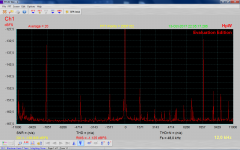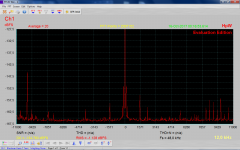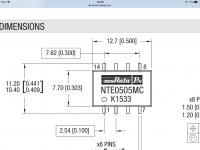Given that the talk turned to the quality of clocks in these dacs..
Here I would like to show a little test that I wished to do.
With this new arrival, the SITO V. 1.2 dac equiped with very good quality clocks, dedicated power supply, & galvanic isolation - I had been wondering if one would be able to detect any measurable changes due to this. I mean any change from the previous model Mirand V 1.1 dac to the SITO dac.
The old model, as we know, is based on Fox Xpresso crystals, have a mixed power supply scheme and is not isolated galvanically.
It looked to be not that easy because the usual jitter tests already for the Mirand dac looked quite clear.
So I tried to push the setup to the limits.
I drive the DUT dac modules into my usual EMU1616m card with AK5394A.
The dac is piloted in upsampled PCM mode, set to 384kHz -so as to stress as much as possible the jitter response.
The sound card is used instead in it's cleanest mode, 48kHz/ 24bit recording.
The first shot is the Mirand V 1.1 original version.
The second shot is the SITO V. 1.2 new version, tested on it's USB input, with USB power external.
Here I would like to show a little test that I wished to do.
With this new arrival, the SITO V. 1.2 dac equiped with very good quality clocks, dedicated power supply, & galvanic isolation - I had been wondering if one would be able to detect any measurable changes due to this. I mean any change from the previous model Mirand V 1.1 dac to the SITO dac.
The old model, as we know, is based on Fox Xpresso crystals, have a mixed power supply scheme and is not isolated galvanically.
It looked to be not that easy because the usual jitter tests already for the Mirand dac looked quite clear.
So I tried to push the setup to the limits.
I drive the DUT dac modules into my usual EMU1616m card with AK5394A.
The dac is piloted in upsampled PCM mode, set to 384kHz -so as to stress as much as possible the jitter response.
The sound card is used instead in it's cleanest mode, 48kHz/ 24bit recording.
The first shot is the Mirand V 1.1 original version.
The second shot is the SITO V. 1.2 new version, tested on it's USB input, with USB power external.
Attachments
Last edited:
The samplng rate is 48kHz multiples, so the test signal is FS/4 frequency, 12kHz tone.
Almost full scale.
In the first graph , the un-isolated Mirand dac shows an obvious modulation at the standard 8kHz high speed USB frames frequency; plus a series of spurs at 1kHz distance, 1msec USB packet signaling.
The 4,5-4,6kHz side lobes most probably are due to the Fox oscillators.
There is a non- zero contribution also from the soundcard itself -- those spurs at 1.5kHz and at the top freq.range. one can observe all these still present also in the SITO spectra.
On the other hand, the SITO V. 1. 2 spectra shows a much cleaner picture, almost all USB correlated signatures are gone, mainly the soundcard related residuals are left only. (And a spur tone at 2kHz, plus a little 50Hz contamination )
So, I would say that the choices made by Sonny - - are working..
Ciao, G
Almost full scale.
In the first graph , the un-isolated Mirand dac shows an obvious modulation at the standard 8kHz high speed USB frames frequency; plus a series of spurs at 1kHz distance, 1msec USB packet signaling.
The 4,5-4,6kHz side lobes most probably are due to the Fox oscillators.
There is a non- zero contribution also from the soundcard itself -- those spurs at 1.5kHz and at the top freq.range. one can observe all these still present also in the SITO spectra.
On the other hand, the SITO V. 1. 2 spectra shows a much cleaner picture, almost all USB correlated signatures are gone, mainly the soundcard related residuals are left only. (And a spur tone at 2kHz, plus a little 50Hz contamination )
So, I would say that the choices made by Sonny - - are working..
Ciao, G
Hi
To cut the internal 5v, just follow the red arrow and cut the leg at the NTE0505.
Then just set the external 5v at the pins in the red cirkel - red is plus 5v and black is minus.
cheers Anders
Thanks. That's scary... Cut it really.? So it's pin 1 right?
Sonny, would it be a benefit if i would use separate Salas shunt PSU for Crystek clock?
Until now, the DAC V1.1 sound is great and I really like it. It's great that I can use USB or I2S inputs.
Thank you.
Wow.. Super built. How did the salas bib work out for u vantalika?
I personally using the reflector d for digital only
Wow.. Super built. How did the salas bib work out for u vantalika?
I personally using the reflector d for digital only
In this configuration I heard the most natural sound in my system.
PSU Salas made a huge change for the better.
With Salas BiB I separately feed I / V and preamplifier.
With Salas ReflectorD - Mirand DAC.
In this configuration I heard the most natural sound in my system.
PSU Salas made a huge change for the better.
With Salas BiB I separately feed I / V and preamplifier.
With Salas ReflectorD - Mirand DAC.
Great to hear. Will try to build it. Have the bib board but was being lazy. Thanks for the review
Your built looks so delicious. Yumm
Last edited:
Pin 8
Hi
It’s actually pin 8 - see picture
Hi
It’s actually pin 8 - see picture
Thanks. That's scary... Cut it really.? So it's pin 1 right?
Attachments
Hi
It’s actually pin 8 - see picture
Okay thanks aboe
Hi Sonny
Hope you are doing good.
My dac is sounding very well, better than some of r-2r dac's my friends own. However there is a small glitch when playing DSD using Allo USB Bridge as Roon end point.
When I play DSD 64/128 native I get no sound or sometimes buzzing sound from my speakers. When I cycle through the filters it picks up again and starts playing till I power off the dac. Any idea what could be the reason? I don't have any problems with PCM.
It's running the same firmware I got with the dac. The links to newer firmware you shared were not working. My marantz SA8005 CD player which also works as a USB DSD dac doesn't have this problem.
Any help would be appreciated.
Hope you are doing good.
My dac is sounding very well, better than some of r-2r dac's my friends own. However there is a small glitch when playing DSD using Allo USB Bridge as Roon end point.
When I play DSD 64/128 native I get no sound or sometimes buzzing sound from my speakers. When I cycle through the filters it picks up again and starts playing till I power off the dac. Any idea what could be the reason? I don't have any problems with PCM.
It's running the same firmware I got with the dac. The links to newer firmware you shared were not working. My marantz SA8005 CD player which also works as a USB DSD dac doesn't have this problem.
Any help would be appreciated.
Last edited:
It needs the 5v
The Dac needs the 5v, but it is only used as a handshake, so the dac know there is an input.
Cheers
Aboe
thanks Joseph
so it will be ok to only use 3 wire usb from my PC
Have someone try to change the clocks on the 1.0 dac board..CCHD-575-25-24.576
The Dac needs the 5v, but it is only used as a handshake, so the dac know there is an input.
Cheers
Aboe
- Home
- Vendor's Bazaar
- AK4490 USB Dac with dsd support.


